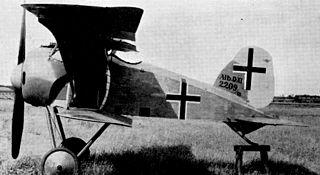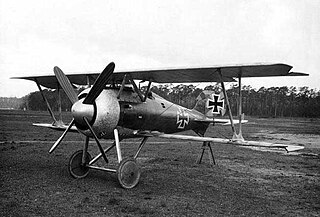| D.VII | |
|---|---|
 | |
| Role | Single seat fighter aircraft |
| National origin | Germany |
| Manufacturer | Pfalz Flugzeugwerke |
| First flight | Late 1917 |
The Pfalz D.VII was a German biplane fighter aircraft from World War I. It was not put into production.
| D.VII | |
|---|---|
 | |
| Role | Single seat fighter aircraft |
| National origin | Germany |
| Manufacturer | Pfalz Flugzeugwerke |
| First flight | Late 1917 |
The Pfalz D.VII was a German biplane fighter aircraft from World War I. It was not put into production.
The D.VII was a single-bay biplane with staggered, parallel-chord wings. It had simple parallel interplane struts; the upper centre section was supported on each side by a three-sided rectangular frame, open at the bottom where it was mounted on the upper fuselage. There were externally connected ailerons on both upper and lower planes. [1]
Behind the D.VII's rotary engine its fuselage was of rounded cross-section, with the single-seat, open cockpit just below the upper wing's trailing edge, where there was a small cut-out for better upward vision. The horizontal tail was mounted at mid-fuselage; the fin was straight-edged and carried a full, rounded and horn balanced rudder. The D.VII had a simple fixed conventional undercarriage, with mainwheels on a single axle supported at each end by a thin V-form pair of struts. There was a generous tailskid. The D.VII had a pair of fixed LMG 08/15 machine guns, the standard German single-seat fighter armament of the time. [1]
Beginning its flying programme near the end of 1917, the Pfalz was fitted with three types of rotary engines in testing: the 108 kW (145 hp) Oberursel U.III, the Goebel Goe.III and the Siemens-Halske Sh.III, the last two both producing 119 kW (160 hp). These drove both two and four blade propellers. Both balanced and unbalanced ailerons were tried. [1]
The D.VII was one of three Pfalz aircraft which competed at the first D-Type contest held at Adlershof in January and February 1918, the others being the D.VI and the D.VIII. It gained its Type Certificate in February 1918 but did not receive a production order. [1]
Data from Green & Swanborough [1]
General characteristics
Performance
Armament

The Siemens-Schuckert D.IV was a late-World War I fighter aircraft from Siemens-Schuckert (SSW). It reached service too late and was produced in too few numbers to have any effect on the war effort.

The Albatros D.XI was a German single-seat fighter sesquiplane first flown in February 1918. It was the first Albatros fighter to use a rotary engine, in the form of the 120 kW (160 hp) Siemens-Halske Sh.III, and also featured a new wing construction with diagonal struts from the fuselage replacing traditional wire bracing.

The Pfalz D.VIII was a German World War I fighter aircraft.

The Siemens-Schuckert D.I was a single-seat fighter built by Siemens-Schuckert Werke in 1916. It was a German copy of the French Nieuport 17 that was obsolete by the time it was available in numbers, so that it served mainly as an advanced trainer.

The Siemens-Schuckert D.III was a German single-seat fighter built by Siemens-Schuckert Werke. The D.III was a development of the earlier Siemens-Schuckert D.IIc prototype. The D.III was an (nearly) equal-span biplane powered by a 160 hp (119 kW) Siemens-Halske Sh.III bi-rotary engine. Idflieg placed an order for 20 aircraft in December 1917, followed by a second order of 30 aircraft in February 1918.

The LFG Roland D.II was a German single-seat fighter of World War I. The type was manufactured by Luftfahrzeug Gesellschaft, and also by Pfalz Flugzeugwerke under license.

The Pfalz Dr.I was a German fighter prototype of World War I. Official interest in the potential of the triplane configuration for single-seat fighters prompted Pfalz to develop the Dr.I. It underwent initial testing in October 1917, and an initial batch of 10 aircraft were shipped to the Front and arrived in April 1918.

The Siemens-Schuckert D.VI was a single engine, single seat, parasol wing German fighter aircraft flown in 1919.

The Siemens-Schuckert DDr.I was a World War I German twin engine, push-pull configuration triplane fighter aircraft. Only one was built, crashing on its first flight.

The Kondor D 6 was a prototype German biplane fighter aircraft flown in 1918. In the interests of better upward vision for the pilot, its upper wing was in two halves, separated over the central fuselage. Its development was soon abandoned.

The Pfalz D.XV was a German single seat fighter aircraft which was approved for production right at the end of World War I, too late to enter service.

The Pfalz D.VI was a German sesquiplane fighter aircraft from World War I. It was not put into production.

The Luft-Fahrzeug-Gesellschaft (LFG) Roland D.VII was a German single seat, single engine biplane fighter aircraft built during World War I. Problems with its underdeveloped V-8 engine prevented its production.

The LFG Roland D.IX was a World War I German single seat fighter aircraft, a biplane powered by one of a new generation of powerful rotary engines. Three slightly different prototypes were built but there was no series production.

The LFG Roland D.XV was a World War I German single seat fighter aircraft, ordered as a test-bed for engine comparisons. It was distinguished from earlier Roland biplane designs by the elimination of flying wires. Two later aircraft, also called LFG Roland D.XV, were completely different designs with slab sided fuselages.

The LFG Roland D.XVI, initially designated the LFG Roland E.I, was a single-seat, single-engine, parasol wing German fighter aircraft flown close to the end of World War I. Only two were built.
The Schütte-Lanz D.VII was a single engine, biplane fighter aircraft designed and built in Germany towards the end of World War I.

The Siemens-Schuckert Dr.I was a German single seat triplane fighter aircraft first flown in 1917. Its development and that of a more powerful, uncompleted variant, was abandoned after a flight test programme.

The Pfalz Dr.II was a German triplane fighter prototype of World War I built by Pfalz Flugzeugwerke.

The Kondor D 2 was a German single seat, biplane fighter aircraft designed and built close to the end of World War I.